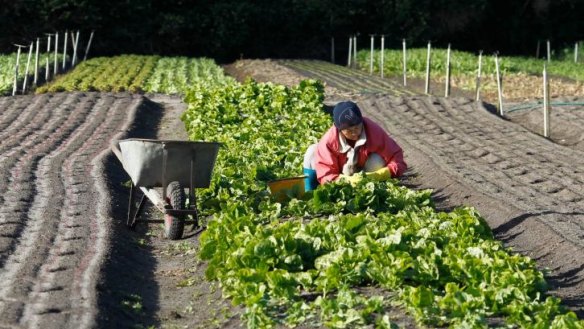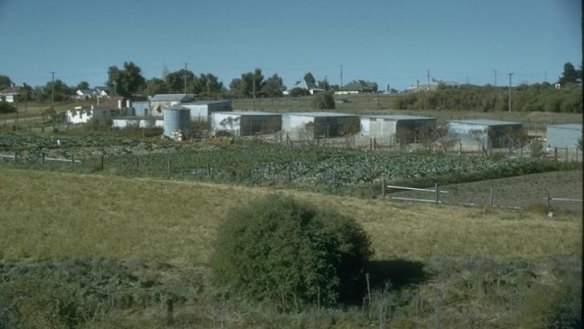Chinese gardens a fertile ground for Canberra region

In our Kitchen Garden column of July 16, we featured the Chinese Market Garden at the Museum of Sydney. Readers responded.
Canberran Myra Dowling recalls, as a small child in the 1950s in Rockhampton Queensland, Georgie the Chinaman would come to her grandmother’s side gate with his horse and cart and sell her vegetables from his market garden. Sometimes her grandmother (a Scandinavian) would exchange her spare eggs for his vegetables. They were great friends but she would tell Myra what a lonely life it was for Georgie, far from family and home.
Melbourne reader Pamela Robinson says her dad grew vegetables and he was half Chinese. Their family history is on the web, The Lew Shing Family. She remembers old men called Ah Bah in Cantonese walking in Little Bourke Street (China Town in Melbourne) with a stick across their shoulders with two big cans on each side. They had hot coals in the bottom of the cans and layers of the best dim sims. She can still recall the smoke coming out of windows where they had opium dens.

Robyn and Paul Atherton live in Harden. In their back yard there is an old loquat tree that fruits well every year. Younger fruit trees that are growing well include plum, peach, apricot and olive and, this year, Robyn has '‘put down a few jars of olives’' with garlic, peppercorn and rosemary. In winter they grow spinach, beetroot, herbs and spring onions.
Robyn is president and research officer of Harden-Murrumburrah Historical Society (HMHS). When she was a member of Advancing Harden Murrumburrah and looking at promoting their history and the town, she enquired about the Chinese portion of the town’s cemetery and how it could be repaired/restored. That led to her researching the topic and, in 2010, the publication by HMHS of her book They were more than just gold diggers – the Chinese of Murrumburrah and surrounding districts 1860s to 1960s.
Market gardening by the Chinese, from the gold days to the 1950s, extended from the goldfields to Murrumburrah’s creeks. Hawkers from this district travelled to Galong and Boorowa to the east and to Temora to the west.
Atherton says the Chinese were fairly established as market gardeners. They were the main supplier of fresh vegetables to the Burrangong Hospital (Burrangong Argus 1876). That year, at the hospital’s monthly meeting, payment was approved for payments to be made to ''Sun Kum Hang for sundries’' and to ‘'a Chinaman for vegetables’'.
Potatoes were being grown at Wombat on ground leased from John Kildea by Ah Fook and Ah Goy. ‘'The Chinamen had been his tenants for three or four years, they lived in two huts about 250 yards apart. One hut was in a cultivation paddock which was fenced from an adjoining paddock where Mr Kildea ran his cattle.” (Burrangong Argus 1881).
Atherton says Willie Sing was bucking the trend by extending his vegetable garden enterprise on Currawong Creek to opening a store in the heart Harden. In 1911 an ad in the Murrumburrah Signal reported that Sing could supply the best of fresh fruit and good vegetables, confectionery, hot pies and coffee.
In 1912 it was reported that eight bags of green peas were sent to Sydney that had been “grown at the Chinaman’s garden at Black’s old dairy on the Currawong Creek and were of prime quality. This shows that it can be done with adequate water supply.”
Andrew Hee wrote some histories for Atherton’s book including Albert Gee, a vegetable hawker and poultry farmer who went to Murrumburrah in 1943. Gee sold from door-to-door from his T-Model Ford that he bought from an Aboriginal family.
Also included in the book is the history of Jow Hee, market gardener and poultry farmer, who was the father of Andrew Hee. Jow Hee owned and operated a fruit and vegetable shop in Randwick but moved to Murrumburrah in 1942.
Jow Hee hawked vegetables door-to-door, from a ute converted from a 1927 Chevrolet tourer, calling on customers once a week. On weekends, his son, Andrew, then aged about nine, went with him to open and close the many gates from Wallendbeen to Nubba. By 1946 he had built up his flock of laying hens to 4000. He bought a rotary hoe and, when the drought broke in 1947 and the wealth of the district grew, the demand for eggs and vegetables increased and he sold these wholesale to local shops. The main crops were cauliflowers and lettuce.
The remainder of the story is fascinating but you will have to read the book, which is available from Robyn Atherton, Harden-Murrumburrah Historical Society, PO Box 237, Harden NSW 2587 ($20 + postage approx. $9).
Susan Parsons is a Canberra writer.
Restaurant reviews, news and the hottest openings served to your inbox.
Sign up